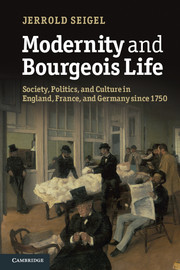 Modernity and Bourgeois Life
Modernity and Bourgeois Life Book contents
- Frontmatter
- Contents
- Illustrations
- Preface
- 1 Introduction: ends and means
- Part I Contours of modernity
- 3 Monarchical centralization, privilege, and conflict: France
- 4 Localism, state-building, and bürgerliche Gesellschaft: Germany
- 5 Modern industry, class, and party politics in nineteenth-century England
- 6 France and bourgeois France: from teleocracy to autonomy
- 7 One special path: modern industry, politics, and bourgeois life in Germany
- Part II Calculations and lifeworlds
- 9 Men and women
- 10 Bourgeois morals: from Victorianism to modern sexuality
- 11 Jews as bourgeois and network people
- Part III A culture of means
- 13 Bourgeois and others
- 14 Bourgeois life and the avant-garde
- 15 Conclusion
- Notes
- Index
7 - One special path: modern industry, politics, and bourgeois life in Germany
Published online by Cambridge University Press: 05 June 2012
- Frontmatter
- Contents
- Illustrations
- Preface
- 1 Introduction: ends and means
- Part I Contours of modernity
- 3 Monarchical centralization, privilege, and conflict: France
- 4 Localism, state-building, and bürgerliche Gesellschaft: Germany
- 5 Modern industry, class, and party politics in nineteenth-century England
- 6 France and bourgeois France: from teleocracy to autonomy
- 7 One special path: modern industry, politics, and bourgeois life in Germany
- Part II Calculations and lifeworlds
- 9 Men and women
- 10 Bourgeois morals: from Victorianism to modern sexuality
- 11 Jews as bourgeois and network people
- Part III A culture of means
- 13 Bourgeois and others
- 14 Bourgeois life and the avant-garde
- 15 Conclusion
- Notes
- Index
Summary
Of all European countries the one most strikingly transformed in the second half of the nineteenth century was Germany. A region hitherto devoid of both an integrated market that could foster and reward the development of productive resources, and of a national state able to draw on and give direction to the wealth they generated, suddenly acquired both. The results were especially momentous because the population and resources linked together by railroads and telegraphs were large in scale and because the state that emerged was subject to few of the constitutional restraints that elsewhere mitigated the pure pursuit of power. Supporters of the National Society founded in 1859 had hoped to give a more liberal quality to a united Germany by resting it on a foundation of expanded connections, both commercial and cultural, between its regions, overcoming the long-established fragmentation by multiplying the means through which individuals could independently become what Christoph Wieland had called “actual men of the nation,” and thus increasing both their numbers and their influence. But the liberals’ inability to bring about unification on this basis, and Bismarck’s success in effecting it instead as part of his strategy to preserve the militaristic and authoritarian character of the Prussian state, demonstrated the dependency of Bürger politicians on the very monarchical authority whose character they had hoped to transform. Instead of yielding some of its power to social forces outside it, the Bismarckian Empire raised the traditional domination of the state over society to a higher level, keeping effective power in the hands of ministers and officials and severely limiting the influence of the organized national parties that in Germany as elsewhere now became a significant feature of public life. One result was that the social and political modernization that in France underpinned Gambetta’s faith in the country’s ability to manage its affairs through parliamentary give-and-take and without recourse to violence took very different forms in Germany, with results that would play a role in the country’s later susceptibility to authoritarian appeals. Pace many eminent historians, there was indeed a German Sonderweg, a special path to and within modernity – just as there was an English and a French one too.
- Type
- Chapter
- Information
- Modernity and Bourgeois LifeSociety, Politics, and Culture in England, France and Germany since 1750, pp. 224 - 264Publisher: Cambridge University PressPrint publication year: 2012
